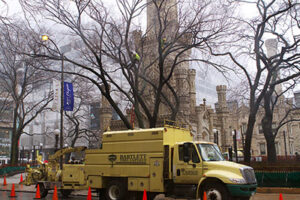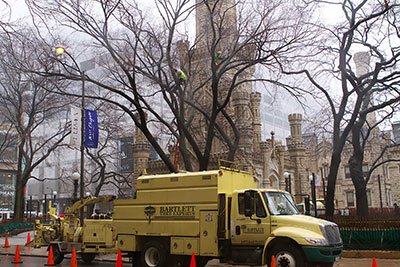Austin Tree Experts understand the art and science of tree care. Their expertise helps maintain a healthy landscape and prevents dangerous situations such as tree failure.

They trim branches to avoid them intersecting with power lines, and they know how to diagnose and treat diseases. They are also trained to spot the signs of a dying tree and can help you decide whether it is worth saving or removing altogether.
During natural disasters, such as tornadoes, hurricanes, and ice storms, the stress on trees can make them vulnerable. When a tree is damaged or dies, it can create hazards such as blocking roads, damaging buildings, and endangering people’s safety. As a result, hundreds of millions of dollars are spent each year to remove debris caused by these events. However, this can be avoided with preparation and planning.
One of the first steps is having a comprehensive tree inventory. This will help communities pre-calculate their potential debris from a severe storm. The Department of Natural Resources Urban and Community Forestry Program has recently partnered with the National USDA Forest Service to train a state strike team that can be activated during a natural disaster to conduct tree risk assessments.
This team can be requested through the local, county, or state Emergency Management Agency offices. Once the request is made, qualified arborists will be dispatched to evaluate the hazard tree risk and eligibility for FEMA reimbursement. The goal of this project is to foster improved consideration and protection of the urban forest by lead agencies during disaster response, mitigation, and post-disaster recovery.
In addition to having an inventory, community officials can prepare for a natural disaster by training their staff to recognize the signs of damage or death in a tree and by educating the public about proper tree care. Other ways to protect a community’s trees include establishing buffer zones, removing combustible materials and clearing brush around them, and pruning or installing bracing systems.
Removing dead branches
Aside from being an eyesore, dead branches can pose a serious hazard during bad weather. These limbs may fall and cause property damage, especially in high winds. Moreover, they hinder the growth of healthy branches and can weaken the entire tree. Consequently, they need to be removed promptly. However, removing dead tree branches isn’t as simple as it sounds. If you’re not an arborist, the job could go awry.
A common reason for a branch to die is a lack of light. As a tree grows and its canopy expands, the new branches will stretch higher than the old ones. This results in shade, causing the lower branches to stop producing energy and eventually die. Alternatively, they may be affected by pests or disease or simply get too heavy and break off.
Branches that are too low or touching your house can be trimmed next, providing an aesthetic update and eliminating the hazard of falling limbs. Additionally, a fungus called wood conk is another sign of a dying branch and should be pruned immediately. Lastly, branches that are crooked or have signs of structural failure should be cut and removed immediately, as they’re a tripping hazard for passersby.
When removing a branch, it’s important to ensure that the cut is clean and that it doesn’t damage the branch collar. The branch collar is a bulge at the base of the branch where it connects to the trunk. You can locate it by looking for a ridge or area where the bark is thicker. It’s important not to damage the branch collar, as it will eventually move in over the wound and seal it.
You should never try to remove a large portion of a tree’s top or its root system, as this can lead to structural imbalance and even tree death. If you’re not an experienced arborist, it’s advisable to call an expert in the field to do the job for you. The professionals at Bartlett have the training and tools to do the job safely and efficiently, without compromising your home or safety.
Trimming shrubs and bushes
Trimming shrubs and bushes isn’t just about aesthetics; it directly benefits the health of these plants by removing dead or damaged stems and branches. It also helps to lighten the load and increase air flow for the remaining growth. This will also reduce the chances of pest infestations. A regular pruning routine will help the plants grow in a healthy fashion that promotes the development of flowers, fruits, and foliage.
A professional tree trimming service will prune the bushes and shrubs in your yard to keep them in their most desirable shape and size. They will use a number of different tools and techniques to achieve the desired results. This includes using shears to cut the shrubs into a more natural form. They will also remove any unsightly branches, waterspouts, or suckers that detract from the overall look of the plant.
When a plant is not properly pruned, it can become damaged and even die. This is especially true if the plants are in close proximity to power lines, sidewalks, or street lights. Having these plants regularly trimmed by an arborist will help eliminate the risk of them becoming a safety hazard in the future.
Ideally, shrubs and bushes should be pruned in the winter while they are dormant. This will help the plants recover more quickly than if they were trimmed in the spring or summer. It will also prevent the spread of diseases such as oak wilt.
If you are looking for a tree trimming company, look for one that has extensive experience in the area where you live. This will ensure that they understand the unique needs of your landscape. They will also know how to avoid damaging the plants and will provide you with the best possible results.
Stump Grinding
A well-cared-for tree adds beauty, safety, and value to a home or business. However, an unruly or ill-maintained tree can wreak havoc on surrounding structures and the landscape. This is why it is essential to hire a professional tree service to perform all arboricultural services for the trees in your yard. You want a company that understands the engineering principles of tree safety, the horticulture of arboreal health, and the artistry of trimming.
A good tree service is licensed and insured to perform all the above tasks in a safe manner. Licensing requires minimum levels of liability insurance, adherence to workers’ compensation rules, and regular training in the latest techniques, equipment, and research findings. It is also important that the tree service be bonded, which protects you from financial loss in the event of an accident on your property.
Tree stumps are not only an eyesore, but they can also impede the flow of water and nutrients to surrounding plants. Additionally, they can cause tripping hazards and interfere with lawn mowers. A professional tree service can grind stumps, removing the aboveground portion of the tree while destroying most or all of the roots underground.
Stump grinding is an environmentally friendly option that reduces the amount of material that ends up in landfills. It can also make the area around a stump usable for other purposes, such as new landscaping or garden beds. Moreover, it can help prevent future problems, such as wood rot and root invasions, by eliminating the source of moisture and nutrient sources.
